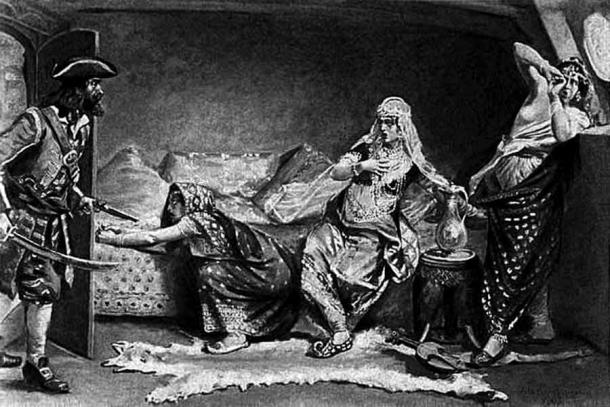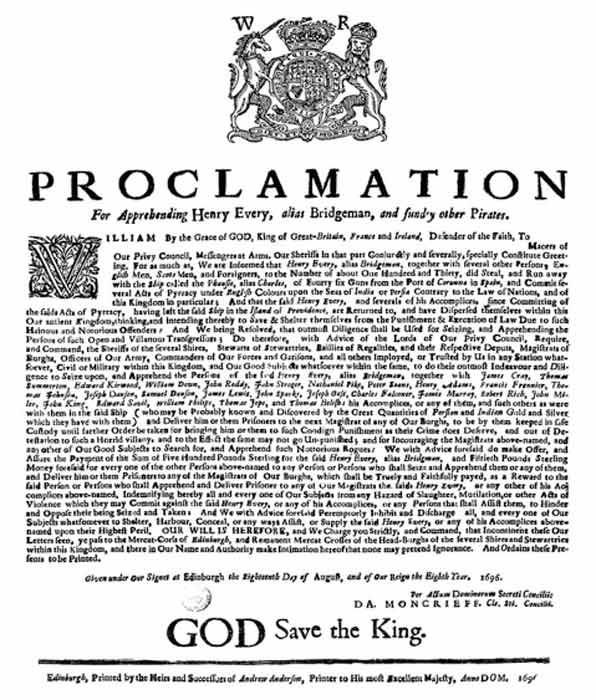Henry Every (Avery) was a brutal English pirate who operated in the Atlantic and Indian Oceans in the mid-1690s. Assuming the names “Jack,” “Benjamin Bridgeman,” and “Long Ben,” in 1695 AD Capt. Henry Every plundered a ship carrying Muslim pilgrims and after posing as a slave trader he sailed out of history and was never seen again.
Jim Bailey, 53, is an anthropological degree holder from the University of Rhode Island who explored the Wydah Gally pirate shipwreck off Cape Cod in the late 1980s. Now, with his metal detector, Bailey has discovered what AP News describe as “the first intact 17th-century Arabian coin discovered in the U.S.A., in a meadow in Middletown,” New Jersey. And this discovery means that pirate Every might just have sailed right back into history.
17th century coin minted in #Yemen, found in a Rhode Island orchard, linked to killing of hajj pilgrims in 1695, @AP‘s @billkole reports. https://t.co/22UnaTF70e
— Jon Gambrell جون (@jongambrellAP) April 2, 2021
Arabic Coin Helps Track the Blood Thirsty Salty-Dog
In 1695 Captain Every commanded the pirate ship Fancy, and on September 7 he ambushed and captured the Ganj-i-Sawai, a royal ship owned by Indian emperor Aurangzeb. The ship was loaded with Muslim pilgrims and “millions of dollars worth of gold and silver.” It is said Every’s men “tortured and killed the men aboard the Indian ship and raped the women” before they escaped to the Bahamas. Under extreme pressure from the royal dynasty of India, and the leaders of the East India Company, King William III of England put a Price on Every’s head, but the salty dog is believed to have sailed to Ireland in 1696 where he vanished for all time.

Some accounts claim that the pirate raped a relative of the Indian emperor Aurangzeb who he discovered on board. ( Public domain )
In 2014 Bailey was metal detecting at Sweet Berry Farm in Middletown where he found “a darkened, dime-sized silver coin he initially assumed was either Spanish or money minted by the Massachusetts Bay Colony.” When Bailey wiped away the mud and looked closer at the find, he made a surprising discovery. There was Arabic text on the coins! Now, Jim Bailey has told the The Newport Daily News that the coins he and others have discovered in New Jersey represent “evidence the notorious pirate first made his way to the American colonies, where he and his crew used the plunder for day-to-day expenses while on the run.”

Royal proclamation for capturing Henry Every, known as Bridgeman, and other pirates. ( Public domain )
Running, Settling and Integrating: Did Every Hide in the New World?
Scientists later determined the Arabic coin had been minted in 1693 AD somewhere in Yemen. This coin joins a swelling collection of ten Arabian coins dating to the same period unearthed in Massachusetts and three more that were found on Rhode Island, with two discovered in Connecticut. It is always said a mystery can be solved if you “follow the money” and perhaps the most intriguing Arabic coin discovered in America was unearthed in North Carolina where historians believe Every’s men came ashore in the New World.
Sarah Sportman is the state archaeologist for Connecticut and she told the Newport Daily News that the Arabic coin found at the 17th-century farm site suggests some of Every’s pirates “settled in New England and integrated.” However, the story about how the coin got here is what will be remembered in history, and that story is told in Jim Bailey’s recent paper published in the journal American Numismatic Society .
A Demon Hiding Amongst Devils: Posing as a Slaver
Historians say Every assured his safe journey to the Americas by posing as a slave trader at a time when the seas were so full of slavers that the pirate, come human-trafficker, passed unnoticed. It is known that when he landed in the Bahamas he visited the French island of Reunion and bought several Black slaves to enhance the illusion that he was a functioning slave trader . He then switched the name of his ship from Fancy to Sea Flower before he navigated northwards along the Eastern seaboard, with nearly four dozen slaves, arriving in Newport, Rhode Island, in 1696.
The discovery of this rare Arabic coin is rocking the pirate world, and knowing the value of his discoveries Jim Bailey told press that he keeps his most valuable discoveries in a secure deposit box, and “not at his home,” so to deter any modern day pirates who might come “a-looking for me treasure.”
Top image: The discovery of an Arabic coin in a Rhode Island orchard provides clues about the escape of the notorious fugitive Captain Every. Source: Allen & Ginter / CC0
By Ashley Cowie
 RSS Feed
RSS Feed















 April 3rd, 2021
April 3rd, 2021  Awake Goy
Awake Goy  Posted in
Posted in  Tags:
Tags: 













